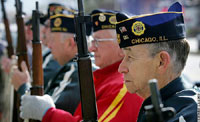US war veterans are quarter of homeless
The research shows that military veterans are a quarter of the homeless in the U.S.A., though they are only 11 percent of population.

And homelessness is not just a problem among middle-age and elderly veterans. Younger veterans from Iraq and Afghanistan are trickling into shelters and soup kitchens seeking services, treatment or help with finding a job.
The Veterans Affairs Department has identified 1,500 homeless veterans from the current wars and says 400 of them have participated in its programs specifically targeting homelessness.
The National Alliance to End Homelessness, a public education nonprofit, based the findings of its report on numbers from Veterans Affairs and the Census Bureau. 2005 data estimated that 194,254 homeless people out of 744,313 on any given night were veterans.
In comparison, the VA says that 20 years ago, the estimated number of veterans who were homeless on any given night was 250,000.
Some advocates say the early presence of veterans from Iraq and Afghanistan at shelters does not bode well for the future. It took roughly a decade for the lives of Vietnam veterans to unravel to the point that they started showing up among the homeless. Advocates worry that intense and repeated deployments leave newer veterans particularly vulnerable.
"We're going to be having a tsunami of them eventually because the mental health toll from this war is enormous," said Daniel Tooth, director of veterans affairs for Lancaster County, Pennsylvania .
"When the Vietnam War ended, that was part of the problem. The war was over, it was off TV, nobody wanted to hear about it," said John Keaveney, a Vietnam veteran and a founder of New Directions in Los Angeles , which provides substance abuse help, job training and shelter to veterans.
"I think they'll be forgotten," Keaveney said of Iraq and Afghanistan veterans. "People get tired of it. It's not glitzy that these are young, honorable, patriotic Americans. They'll just be veterans, and that happens after every war."
Keaveney said it is difficult for his group to persuade some homeless Iraq veterans to stay for treatment and help because they don't relate to the older veterans. Those who stayed have had success _ one is now a stock broker and another is applying to be a police officer, he said.
"They see guys that are their father's age and they don't understand, they don't know, that in a couple of years they'll be looking like them," he said.
The Iraq vets seeking help with homelessness are more likely to be women, less likely to have substance abuse problems, but more likely to have mental illness - mostly related to post-traumatic stress, said Pete Dougherty, director of homeless veterans programs at the VA.
Overall, 45 percent of participants in the VA's homeless programs have a diagnosable mental illness and more than three out of four have a substance abuse problem, while 35 percent have both, Dougherty said.
Historically, a number of fighters in U.S. wars have become homeless. In the post-Civil War era, homeless veterans sang old Army songs to dramatize their need for work and became known as "tramps," which had meant to march into war, said Todd DePastino, a historian at Penn State University's Beaver campus who wrote a book on the history of homelessness.
After World War I, thousands of veterans - many of them homeless - camped in the nation's capital seeking bonus money. Their camps were destroyed by the government, creating a public relations disaster for President Herbert Hoover.
The end of the Vietnam War coincided with a time of economic restructuring, and many of the same people who fought in Vietnam were also those most affected by the loss of manufacturing jobs, DePastino said.
Their entrance to the streets was traumatic and, as they aged, their problems became more chronic, recalled Sister Mary Scullion, who has worked with the homeless for 30 years and co-founded of the group Project H.O.M.E. in Philadelphia.
"It takes more to address the needs because they are multiple needs that have been unattended," Scullion said. "Life on the street is brutal and I know many, many homeless veterans who have died from Vietnam."
The VA started targeting homelessness in 1987, 12 years after the fall of Saigon. Today, the VA has, either on its own or through partnerships, more than 15,000 residential rehabilitative, transitional and permanent beds for homeless veterans nationwide. It spends about $265 million ( EUR 180 million) annually on homeless-specific programs and about $1.5 billion ( EUR 1 billion) for all health care costs for homeless veterans.
In all of 2006, the National Alliance to End Homelessness estimates that 495,400 veterans were homeless at some point during the year.
Subscribe to Pravda.Ru Telegram channel, Facebook, RSS!


